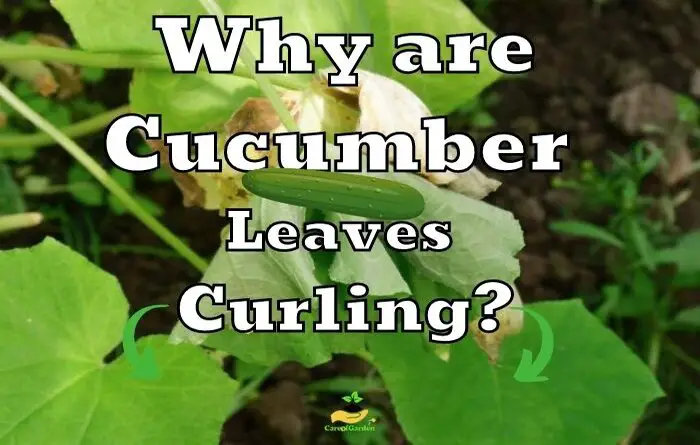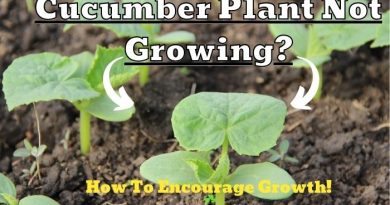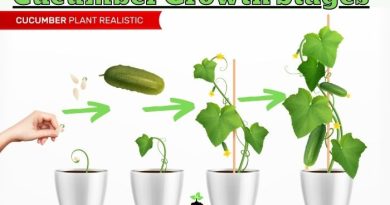Why are Cucumber Leaves Curling? (Quick Answer)
There can be many reasons why cucumber leaves are curling, like: improper care, diseases, and the invasion of pests. In this article we show you 6 causes which led to this issue and what to do to prevent the cucumbers leaves from curling.
| Reasons Cucumber Leaves are Curling: |
|---|
| 1. Lack of water |
| 2. Nutrient deficiency |
| 3. High Temperature or Low Temperature |
| 4. Pest infestation |
| 5. Diseases |
| 6. Overuse of fertilizer |
1. Lack of water
The main and most harmless cause of leaf curling on cucumbers is a lack of moisture or too dry weather. The main indicator that the leaves have curled due to lack of water is that they will begin to dry and fall off the stems.
This can cause the roots to dry out and send signals to the plants cells telling them to start curling up their leaves in an effort to conserve water. It is worth remembering that the soil must be moistened to a depth of at least 4 inches (10 cm), otherwise the green part of the plant will begin to dry and curl.
It should also be borne in mind that for cucumbers, especially when grown in protected ground, dry air is detrimental.
This is a common problem for new gardeners, as it can be difficult to tell when a plant needs water.
You should check the soil around your cucumbers at least once a week and water them if it appears dry. Keep in mind that each cucumber requires approximately 2.5-3 liters of water per day.
Then loosen the soil beforehand and water thoroughly before mulching to maintain the water balance for a long time.
Do not forget to regularly spray the cucumber (this should be done in the morning so that the drops of water have time to dry by the evening).
The optimum air humidity in the greenhouse for cucumbers is 80-95%.
Solution
In order to solve the problem and prevent its occurrence, the following measures are taken:
- It is necessary to restore the optimal water balance of the soil, while avoiding excessive waterlogging.
- When growing cucumbers in a greenhouse, it is necessary to maintain high humidity.
- The average is between 2 and 4 waterings per week. In summer heat, water the soil sufficiently.
Proper watering of cucumbers in a greenhouse is when the soil is moistened to a depth of 4 to 5 inch (10-12 cm). Spray the leaves with warm settled water in the greenhouse during a period of prolonged heat in the morning until the sun is hot.
2. Nutrient deficiency
Another cause of leaf curling is the lack of nutrients in the cucumber soil. Folding the leaves inward with edges or up with tips may be due to a deficiency of macro and micronutrients, which has a very negative effect on the future fruiting of weakened cucumber stems.
At the stage of active growth before flowering, the vegetable crop consumes a lot of nitrogen. During the budding period, combined phosphorus-potassium fertilizers are required.
When the leaves of cucumbers are curling inwards, while acquiring a whitish color, this may indicate a lack of nitrogen. The twisting itself occurs due to the fact that the cucumber rachis ( main vein) in the middle of the leaf grows faster than the leaf blade.
Top dressing with nitrogenous fertilizer, such as ammonium nitrate, can help to cope with the problem. When twisting the leaves up, the plant is fertilized with potassium salt, as this is a signal of a lack of potassium. It is also evidenced by the acquisition of a reddish tint by the leaf;
When the leaves of cucumbers are curling up, most likely, this is a signal of potassium deficiency in the soil. Such plants need to be fed with a solution of potassium salt (3 tablespoons per 10 liters of water).
Solution
| Nutrient Deficiency | Leaf Symptoms | How to treat |
|---|---|---|
| Nitrogen | Curling inwards | It is necessary to fertilize them with urea fertilizer or ammonium nitrate is well suited. |
| Potassium | Curling up | It is necessary that the soil is watered with a solution of wood ash or potassium salt. |
| Calcium | Curling downwards | Calcium deficiency is corrected by adding calcium nitrate. |
| Magnesium | Curling up | Apply Epsom salts dissolved in water or magnesium sulfate. |
- If the leaves have curled inward without changing color or drying out, this may be due to a lack of nitrogen in the soil. In such plants, the central vein grows faster than the leaf blade. To help cucumbers recover, it is necessary to fertilize with nitrogen fertilizers.
- If the leaves have curled up without changing color and density, then there is a lack of potassium. As a solution to the problem, the soil is watered with a solution of wood ash or potassium salt.
Feeding with urea, ammonium nitrate or any other nitrogen fertilizers (according to instructions) will help stimulate the growth of leaf mass.
3. High Temperature or Low Temperature
Cucumbers, like any plant, react equally badly to both a sudden decrease or a sharp increase in temperature. As a result of a too high or low temperature, the leaves curl and turn yellow.
Low Temperature
Low temperatures causes curled leaves if your cucumbers have been left outside in temperatures below 50 degrees Fahrenheit.
Cucumbers are not hardy plants and should not be left outside in temperatures below 50 degrees Fahrenheit. If your cucumber plants have been exposed to cold temperatures, they may start curling their leaves as a form of self-protection against cold damage.
When the temperature drops to 50°F (10 °C), the plant stops absorbing moisture and nutrients, so it will twist and fall over. If temperatures drop even further below 37°F (3°C), cucumbers will die.
Cucumber plants can be damaged by frost even when the temperature is above freezing point. If you live in an area with very cold winters, you may notice that your cucumber plants tend to lose their leaves as soon as there’s a night below freezing temperatures.
This happens because the plant uses up all of its water reserves during the day and cannot absorb any more during extreme cold nights.
When planting cucumbers, you need to choose the right place and protect the bed from rain and cold. For example, you can cover it with foil.
High Temperature
If your cucumber plants have been exposed to high temperatures, they may start curling their leaves as a form of self-protection. High temperature causes curled leaves.
If your cucumbers have been left outside in temperatures above 80 degrees Fahrenheit, they may start curling their leaves as a form of self-protection. As the leaves curl inward, they can block out some sunlight and reduce photosynthesis in order to preserve moisture.
The twisted leaves help keep water inside the plant and prevent it from evaporating too quickly into the atmosphere. You should move them to a cooler environment as soon as possible if high temperatures are causing this problem.
When growing cucumbers in a greenhouse, they should not be allowed to come into contact with glass, as it quickly heats up or cools down. If the crop is grown in open ground, then it is recommended to build a greenhouse from plastic film for it.
To ensure success, you should check and maintain the correct temperature and watering conditions for cucumbers. It is recommended to maintain the air temperature at around 70°F (+21°C), and humidity should be kept at 85-95%.
4. Pest infestation
Let’s say you water your cucumbers regularly, do not allow them to overheat or hypothermia, do not forget about fertilizing, and the leaves still curl. What could be wrong?
Even with proper care of plants, the appearance of insects is not excluded, which can cause leaf curl and crop loss. Most often, cucumbers are affected by aphids or spider mites.
It is very easy to identify such a problem. To do this, you need to look at the back of the leaf: if the cucumbers are affected by pests, then they will be clearly visible on the surface.
A characteristic feature of aphids is the defeat of the entire surface of the leaf, both from below and above. In turn, the spider mite is more difficult to identify due to the fact that traces of its vital activity on the plant remain mainly on its lower side.
If you suspect a spider mite of twisting the leaves, then just turn it over – there you will see a small cobweb. This is 100% proof that the seedlings are affected by pests.
If your fears are confirmed, do not waste time: insects not only inhibit the development of the cucumber, drawing all the juices out of it, but can also carry viruses.
Solution
The most effective way to deal with them is with the help of insecticides:
- Insecticides are used for aphids.
- When attacked by a spider mite, acaricides are used specific for their intended purpose, whose one-time prolonged action will allow you not to overload the soil with toxic substances,
Try to solve the problem with the help of home remedies. To control cucumber pests, gardeners most often use infusions of onion peel, dandelion, celandine, or wood ash. To keep the infusion longer on the leaves after spraying, soap is added as an adhesive.
- From two problems at once (aphids and mites), tincture of onion husks helps well. Just pour boiling water over a glass of dry husk and leave to infuse for a day. Strain the resulting infusion and process the plant every three days.
- A weak solution of potassium permanganate will also rid the soil of traces of aphids and spider mites. As a rule, they go to this stage if the treatment with onion peel did not work. The soil is very carefully treated with a solution no more than once every seven days.
An infusion of garlic is also effective against aphids and spider mites. To prepare it, grind 500 g of cloves, fill them with 3 liters of water and leave for 5 days. Then filter and spray the cucumber leaves with this infusion.
5. Diseases
If the cucumber stems develops well and in the middle of the season the leaves of the cucumbers turn white and begin to curl, then a fungal infection may have occurred: powdery mildew, cucumber root rot or viruses like: mosaic virus.
Powdery Mildew
With powdery mildew, cucumber leaves begin to curl inward and turn yellow, forming a characteristic fluffy, whitish coating. In the middle of summer, the appearance of powdery mildew on vegetable crops is not easy to avoid.
Factors that stimulate the development of this disease are dense plantings, rainy and cool summers, poor ventilation of greenhouses (or balconies where cucumbers are grown), watering with cold water, and sharp temperature fluctuations.
It is possible to understand that the leaf is twisted precisely because of powdery mildew damage by a characteristic whitish coating.
Solution
At the first signs of the disease, spray the cucumbers with a solution of baking soda (dissolve 2 tablespoons of soda in 10 liters of water) with the addition of laundry soap.
You can overcome the disease with the help of a 1% solution of Bordeaux mixture, which is sprayed with cucumbers.
Cucumber root rot
Cucumber leaves often curl around the edges and turn pale as a result of root rot. However, the most characteristic symptoms of this disease are wilting, yellowing of the leaves, starting from the bottom.
In this case, the stem near the ground becomes brown. Most often, the disease affects cucumbers growing in a greenhouse, but sometimes those plants that are in the open field also suffer from root rot.
Solution
To avoid this problem, before planting, disinfect the soil with a pink solution of potassium permanganate, avoid excessive wetting of the plantings, and do not water the plants with cold water. You should also regularly ventilate the greenhouse to prevent overheating of the air.
Dust the lower part of the plants with chalk, wood ash or coal.
Cucumber Mosaic Virus
If your cucumbers do not show any of the above problems, and the leaves are still curling, most likely the cause lies in the defeat of the cucumber mosaic virus.
This is a viral infection transmitted by aphids.
With this disease, spots first appear on the leaves (and later on greens) and it may seem that the plant has chlorosis. However, later growth stops, the leaves decrease in size, curl and fall off.
Solution
To avoid this disease, you need to take preventive measures: before sowing, disinfect the seeds with a solution of potassium permanganate.
Do not plant other crops of the Pumpkin family next to cucumbers, and at the first appearance, start fighting aphids, the main carrier of the disease.
To combat it, the carrier of the virus, the aphid, must be kept away from the cucumber plant.
In this case, it is impossible to cure the plant. If the plant is sick, then it will have to be quickly dug up and burned to prevent the virus from spreading throughout the garden.
6. Overuse of fertilizer
The last reason why cucumber leaves are curling along the edges of the leaf plate is ammonia burn. This happens if you add unrotted manure or an excessive amount of ammonium nitrate under the plant.
You may have used too much fertilizer on your plants recently or frequently enough. Overfertilizing can give your plants an excess supply of vitamins and minerals which can damage their leaves, causing them to curl up in response (this is a good thing).
If you do notice that your plants have curled leaves because they’ve had too much fertilizer, then you should reduce its amount until they stop curling
In this case, it is worth trying to remove the introduced manure from the roots of the plants and water the cucumbers abundantly several times so that the ammonia is washed out of the soil.
In order for ammonia to be washed out of the soil, the plant must be watered abundantly several times. And the manure will have to be raked away from the roots.
How to prevent cucumber leaves from curling
To prevent the leaves from curling in the cucumbers, you need to remember a few rules:
- Top dressing is carried out only when there is a need for it. It is unacceptable to exceed the dosage of fertilizers, even organic ones;
- Cucumbers are watered only with warm water;
- Early sowing is dangerous due to the return of night cold, which means that it is not advisable to rush into it. If the cucumber is greenhouse or indoor, it is important to monitor the level of heat supply from heating devices;
- Regularly inspecting the leaves for damage by insects, you can avoid their reproduction and mass invasion of plantings;
- Perform preventive treatments of vegetable soil beds that don’t allow the appearance of diseases and pests.
Conclusion
The curling of the leaves tells you that the plant is not getting enough water. The opposite can be the cause of an excess of water. If it is not the water, it is due to the draft or a lack of heat.
Most often, twisted leaves indicate improper care for cucumbers. In addition, the plant may be affected by diseases or pests. To determine the specific cause, it is necessary to pay attention to the place of twisting of the leaf, its color and density.
Following this article, you can quickly respond and prevent adverse consequences.
Triggers are either care mistakes or diseases. Watering with very cold water can trigger cucumber wilt, because cucumbers absorb very little or almost no water at low soil temperatures. That’s why they hate cold irrigation water, which really cools the soil around the plant.
To deal with this problem, you simply have to protect the cucumber from the element that is stressing it or, if it is something specific and not very serious, simply wait for it to pass: the plant will recover as soon as its conditions improve again.
Water your cucumber plants thoroughly when the top inch of soil is dry and again every three days if rain hasn’t fallen within a week. Water the cucumbers early in the morning and in the evening. The lukewarm or ambient warm rainwater is important so that the cucumber plants do not suffer a cold shock.
Eggplants leaves also turn white due to 5 reasons presented in this article!




